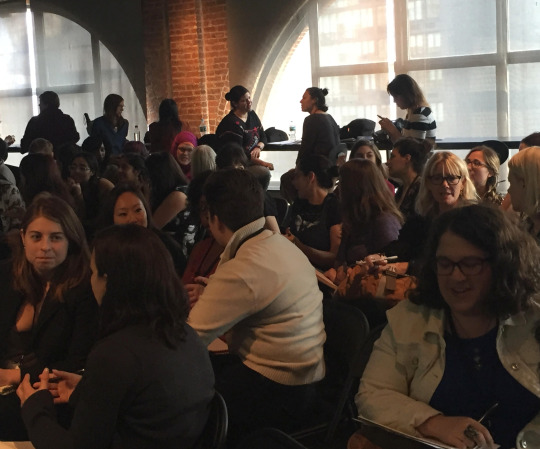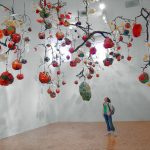Get the Yes: Application Tips for Writers from BinderCon NYC
Planning ahead pays off, and so does “becoming one with the spreadsheet.”
Last fall, NYFA staff members attended BinderCon NYC, a professional development conference for women and gender non-conforming writers. The biannual, bi-coastal conference is hosted by Out of the Binders, a non-profit dedicated to promoting gender parity in the literary world. Find out more about the organization in our interview with Executive Director and Co-Founder Leigh Stein.
In anticipation of BinderCon LA, which takes place April 1 – 2, 2017, we’re sharing tips from a BinderCon NYC session, Get the Yes: Crafting the Best Application for Residencies, Fellowships, Grants, and Workshops presented by Grace Jahng Lee (IAP ’13) and Glendaliz Camacho. Between them, the two writers have been awarded 15 residencies within two years. They’ve also received several grants, fellowships, and scholarships, and have been on the other side of the application process as selection committee members.
Application Essentials
During the presentation, Jahng Lee and Camacho shared their personal best practices for applying, while covering the essential elements of the application process, which often include the following items:
• Artist Statement
• Resume/CV
• Artist Bio or Artist Statement
• Project Description
• Work Plan/Statement of Intent
• References or Letter(s) of Reference
• Writing Sample
One of the first steps to a successful application process is evaluating whether an opportunity is right for you. As Jahng Lee and Camacho pointed out, a writer contemplating a residency should consider a variety of factors, from questions of logistics—When will the residency takes place? Is a stipend provided?—to questions related to your work, such as—Who is on the faculty? How will the location influence my writing? How well do my work and the organization’s mission align?
You can get even more specific with your questions, as visual artist Rosemarie Fiore (Fellow in Printmaking/Drawing/Artists’ Books ‘09) explained in an interview about How to Select an Artist Residency Program: “The type of residency I choose to apply to matches my goal for developing a specific body of work.”
Get Time on Your Side
For many, writing, revising, and workshopping all take time. It may feel difficult to squeeze in time for applications as well. But as Camacho advised: planning ahead will pay off, and so will “becoming one with the spreadsheet.” Organize yourself by arranging opportunities by deadline, and noting application requirements, application fees if applicable, and submission dates.
Break the application process down. Make sure you’re giving your references enough time to write their letters of recommendation, and give yourself the time needed to carefully select your writing sample and revise your artist statement; if it’s your first time writing an artist statement, it’s an especially good idea to go through a few drafts.
A spreadsheet (or calendar, or whichever organizational tool you’re using) can not only help keep you organized, but can also “soften the blow of rejection,” Camacho noted, as a visual reminder that there are many more opportunities coming up.
The Artist Statement
You can rely on your community of fellow writers for encouragement and for help with your application. You may know a lot of writers who have gone through the process of creating an artist statement, for example. Ask them for advice on how to go about writing what is, for some, “the most dreaded piece” of the application. Jahng Lee also recommended workshopping your artist statement with other writers, the same way you’d workshop your creative writing.
If the thought of writing about your work makes you freeze up, jot down phrases that get at the heart of who you are and what you write about. You can “heighten the language” for a more polished artist statement later.

The Writing Sample
When it comes to selecting your writing sample, “we’re often not the best judges of our own work.” Ask for feedback from your peers and your writing group if you have one. Camacho believes the writing sample “has to show you at the height of your skill.” That might mean published or unpublished, or complete or a work-in-progress, so long as the excerpt is polished. Camacho tends to choose the work that’s been best received, or published more than once.
The Letter of Reference
Having peers, editors, or teachers who know you and your writing well can come in handy for several reasons. For one, they can write your letters of recommendation. It can be a better idea to ask people who are familiar with your work, instead of simply asking someone because they are well-known. Avoid causing “the sigh heard ‘round the world” by asking your reference to write a letter from scratch. You can draft a letter for them to modify, which references the specific strengths of yours they’ve seen in action. Just be sure to not be too humble, in case that person simply signs the letter without changing anything. In this case (as in many others, in NYFA’s opinion), it’s ok to brag!
The Artist Bio and Project Description
Peers who know you and your writing can also help you curate your artist bio and offer perspective on what makes you unique. As Jahng Lee told NYFA in a Con Edison Immigrant Artist Program Newsletter interview, she was born stateless and denied citizenship. She found this embarrassing, but her fellow writers found it interesting and helped her connect her distinctive background to themes in her work.
A final surprising resource: the language used on the covers of books that are like your own. When writing a project description, which describes what you’re working on, you can reference the jackets of books that speak to the same themes you grapple with, for an idea of how to frame these parts of the application.
Right Here, Right Now: Create a Sense of Urgency
Even if this question is not asked specifically in the application, answer the question “Why now?” as well as why the particular opportunity for which you’re applying is crucial. If you’re making the case for why you need a residency, don’t just leave it at “because I need time to write.” Is the project you’re working on especially timely? Are you documenting a culture that feels endangered? Then spell that out.
Just Keep Swimming: Additional Resources
If the application process seems daunting, just remember that every writer has assets that can help them “get the yes,” from writing group peers to unique biographical details and spreadsheets. Ready to kickstart your application calendar? Check out our article, “Everything You Need to Know about Literary Submissions.” If you’ve never been published but want to apply for a residency or another opportunity, you might be encouraged to know that Jahng Lee was accepted into several residencies before being published.
Now writers, get those applications started!
To read more articles about creating and sustaining an artistic career across disciplines, visit NYFA’s Business of Art archive. Follow NYFA on Twitter, Instagram, and Facebook for updates on all of NYFA’s programs, including our Immigrant Artist Program.
– Mirielle Clifford, Program Associate, Online Resources
Images, from top: Jahng Lee and Camacho discussing spreadsheet use; participants discussing artist statements. Photo credit: Mirielle Clifford





